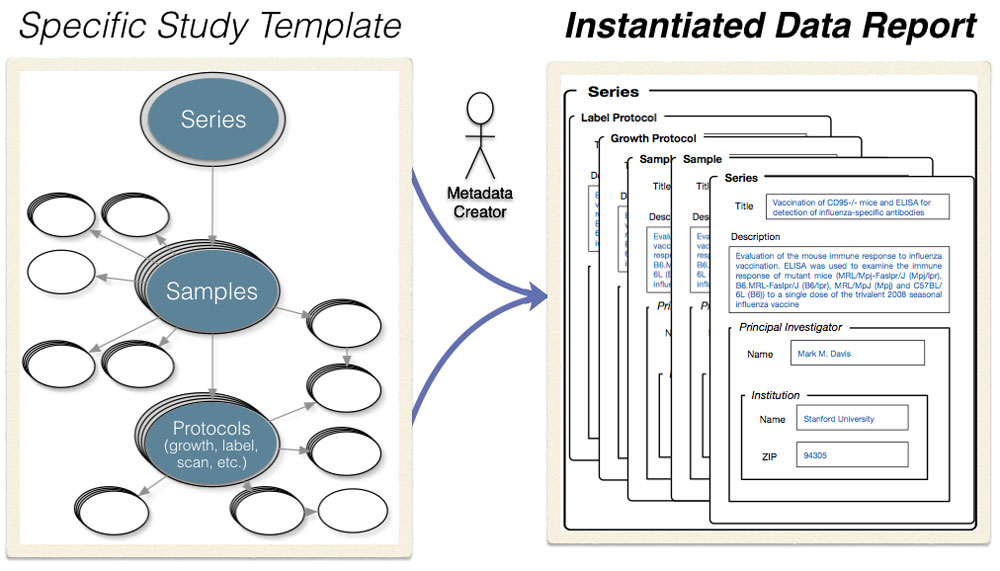User Personas are roles that people take on as part of their job. For example, a biologist may act as a lab manager, a data analyst, a lab technician, and a teaching professor in the course of a single day.
In software development, User Personas are used to describe the target users for the delivered system and its products. In simple cases, each user persona can be briefly titled and described; more advanced systems benefit from having detailed descriptions of hypothetical users, reflecting all their user personas and relevant personal interests and characteristics.
CEDAR is starting by creating simple user personas, as described below. Should this prove insufficient, we will develop more advanced descriptions to meet particular needs.
CEDAR User Personas
The following personas provide basic information only at this stage. More personas, and more details, will be developed as needed for the different project phases.
 Standards Definer (aka Template Creator)
Standards Definer (aka Template Creator)
The Standards Definer creates or selects specifications for others to follow when submitting metadata. This persona may be creating a specification from scratch, or based on existing community standards.
This Standards Definer persona needs to:
- Implement an existing specification as a template (for others to fill in);
- Learn what templates already exist, for a particular purpose or specification;
- Compose templates from more basic components, which themselves may be composed of many elements;
- Extend an existing template for their own purpose;
- Constrain how users of the templates he or she creates fills them out
- See what templates he or she has created, and how they have been used
Dataset Describer (aka Metadata Creator)
 The Dataset Describer has the responsibility to take one or more datasets, and describe the contents using metadata that satisfies the recipient (for example, for a repository, a publisher, a funder, or a manager).
The Dataset Describer has the responsibility to take one or more datasets, and describe the contents using metadata that satisfies the recipient (for example, for a repository, a publisher, a funder, or a manager).
The Dataset Describer persona needs to:
- Understand key aspects of the dataset sufficiently to characterize it in metadata;
- Be able to use a data entry tool to provide the appropriate metadata;
- Fill out the metadata correctly, consistently, completely, and quickly
- Follow the appropriate community-specific guidelines and standards for completing the metadata
Dataset or Collection Curator
A Dataset Curator is someone who works with existing datasets to improve their metadata, including consistency, completeness, and conformance to community guidelines and standards; and make the datasets more useful to the broader community. The curator may be responsible for their own datasets, or a collection (repository) of datasets submitted by other users.
The Dataset or Collection Curator persona needs to:
- Learn what datasets are available for curation;
- Be able to find and examine specific datasets, or collections of datasets;
- Be able to obtain summary statistics on the dataset collections of interest, including analyzing the contents of specific metadata fields;
- Annotate existing datasets with suggestions or corrections to their metadata;
- Review the provenance of metadata for the existing datasets
- Review the status of datasets that he or she curates
Biomedical Researcher
The Biomedical Researcher wants to find datasets across different repositories that are useful for the research being performed. Depending on needs and skills, the Biomedical Researcher may also be a Bioinformatics Developer, going beyond basic capabilities by using software interfaces to the system.
The Biomedical Researcher persona needs to:
- Find all datasets with a given set of characteristics, for example all datasets related to infection;
- Be able to filter datasets based on specific criteria, for example cohorts fitting a particular description;
- See how many datasets exist using different selection facets, for example how many exist with patients in particular age ranges;
- Select datasets according to their archive repositories
- Obtain unique identifiers and access information for any datasets meeting the search criteria, via a user interface and via API
Bioinformatics Developer
The Bioinformatics Developer creates software that leverages the information in the system to create additional capabilities. The new capabilities may be added to CEDAR, or provided via a plugin or external system.
The Bioinformatics Developer persona needs to:
- Access CEDAR information (about templates, metadata, and annotations) using Application Program Interfaces (APIs);
- Provide input to the CEDAR system using APIs;
- Identify the best algorithms for interacting with CEDAR by using documentation on the system's services and data models;
- Understand errors produced by the CEDAR system and fix their services to correct those errors
- Understand any constraints or limits presented by the CEDAR system, so as to work with the system effectively

